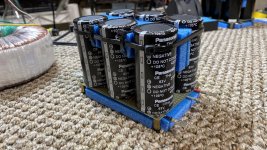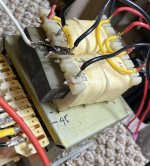I am building power supplies for a couple of kit amplifiers I got. The kits have been tested at 90vdc rails and up to 500w+ into 4 ohms, so they work (long story). They are based of 4 pairs of the njw1302/3281 types per channel.
I built a capacitor bank for a stereo channel comprising 6x 27,000uF caps (3 per rail) See pics, with the eventual goal of pairing it with one of the larger Toroidals I have.
While wiring, I got thinking about how "small" a cap can I put on the amplifier for it to have acceptable sound... I was amazed that a 25VA transformer coupled with a pair of cheap 470uF caps ran the amplifier fine (speakers got to about 104db c-weighted before distorting) . The transformer was still cold on the winding. I did NOT expect that...
What amazed me is that I heard almost no 60Hz hum even with my ears next to the speakers.
So the question is... how low can one go? Whats the lowest you guys have seen PSU caps go?
I built a capacitor bank for a stereo channel comprising 6x 27,000uF caps (3 per rail) See pics, with the eventual goal of pairing it with one of the larger Toroidals I have.
While wiring, I got thinking about how "small" a cap can I put on the amplifier for it to have acceptable sound... I was amazed that a 25VA transformer coupled with a pair of cheap 470uF caps ran the amplifier fine (speakers got to about 104db c-weighted before distorting) . The transformer was still cold on the winding. I did NOT expect that...
What amazed me is that I heard almost no 60Hz hum even with my ears next to the speakers.
So the question is... how low can one go? Whats the lowest you guys have seen PSU caps go?
Attachments
Last edited:
The smaller the capacitor bank, the larger the sawtooth rectification voltage,
for a given bias current. And the more the voltage will sag when playing music
with much low frequency content.
for a given bias current. And the more the voltage will sag when playing music
with much low frequency content.
Last edited:
I had understood that ripple results in audible mains hum at the speaker output. Since that is not an apparent issue for me, why should one worry about ripple? Better measurements?
The level of hum that you hear will also depend on the sensitivity of your speakers. Hum that is inaudible with 80dB speakers may be quite loud with 95dB speakers.
Also the hum that you may or may not hear will probably be a combination of 60Hz, 120Hz, and even 180Hz.
Also the hum that you may or may not hear will probably be a combination of 60Hz, 120Hz, and even 180Hz.
I had understood that ripple results in audible mains hum at the speaker output. Since that
is not an apparent issue for me, why should one worry about ripple? Better measurements?
Lower ripple current stress, and lower internal temperatures for the capacitors, so they will have longer life.
The power supply must also have enough energy storage (1/2 CV^2) to be able to supply the output stage
with current to drive the load under all signal conditions. The rectifiers only work at 120Hz conduction.
Last edited:
I often used this for test/development of my amp plus for lots of other stuff. Its an 18VA 15-0-15 transformer. It has proved its worth countless times. There was also a -/+12 volt supply on there as well as a fast action mute logic level output.
Attachments
Lower ripple current stress, and lower internal temperatures for the capacitors, so they will have longer life.
The power supply must also have enough energy storage (1/2 CV^2) to be able to supply the output stage
with current to drive the load under all signal conditions. The rectifiers only work at 120Hz conduction.
This is very helpful, Thanks. I concur with this. I upped the transformer to a 300va unit 45-0-45vac using the same 470uF caps. I was quite amazed at the sound output. However after a couple of minutes as I monitored the temps of the tiny caps, they rose in temps to about 40c (108f). So this is a concern with using smallish caps. I must be passing 4-5amps through them.
I often used this for test/development of my amp plus for lots of other stuff. Its an 18VA 15-0-15 transformer. It has proved its worth countless times. There was also a -/+12 volt supply on there as well as a fast action mute logic level output.
My rig is also 15-0-15 🙂.
Although I have a stage 2 at 300va 45-0-45
Subjectively, the sound was looser but a bit euphonic ( warm with harmonics) with the 470uF cap. Replacing it with a bank of caps (total 81,000uf per rail) which tightened the bass which was first noticeable. The mids were clearer but not as warm. I then added ( since I had one lying around) another Bank of caps 81,000uF per rail for 162,000uF per rail ( a first for me) the mid started the same, but the bass tightened slightly more.... almost as if it increased in frequency by a fraction of an octave.... quite interesting.
😎
My next level up are two ancient Farnell 0-30 lab supplies with fully adjustable current limiting. They do the job hooked up in series when a bit more voltage is needed.
After that its usually 'proper transformer' time lol.
We all have our own methods 😉
My next level up are two ancient Farnell 0-30 lab supplies with fully adjustable current limiting. They do the job hooked up in series when a bit more voltage is needed.
After that its usually 'proper transformer' time lol.
We all have our own methods 😉
I had understood that ripple results in audible mains hum at the speaker output. Since that is not an apparent issue for me, why should one worry about ripple? Better measurements?
Non-pathological amplifiers tolerate a huge amount of supply hum without passing it to the speakers (special, audiophiliac amplifiers may not be that tolerant).
The output begins to be affected only when the ripple causes early clipping, and this does not cause "true hum": it causes an intermodulation between the 100/120Hz and the audio signal. It doesn't sound like hum, more like a kind of warbling, and some might even find that it "enriches" the sound.
Agrees with my findings on sonics too. The one thing I realized I neglected to mention, is that the amp is running in bridged mode. There might be hum cancellation going on perhaps. But regardless I also tested normal one channel output and could not hear hum, but removing the cap cause a huge audio hum in the 60Hz range plus some multiples... I was surprised how much a 470uF cap can quieten that down.
- Home
- Amplifiers
- Power Supplies
- How small a PSU? Interesting experiment



